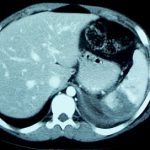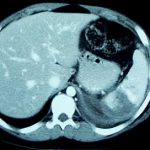Spleen injury grading is not as complicated as people think! The grading system ranges from Grade I (very minor) to Grade V (shattered, devascularized).
There is one nuance that people frequently don’t appreciate: multiple injuries can increase the grade. Technically, multiple injuries advance the maximum grade by one point, up to a maximum of Grade 3. So Grade 1 + Grade 1 = Grade 2, but Grades 2+2 = 3! Weird arithmetic!
The vast majority of injuries are Grades 1 to 3, and they are actually the easiest to grade. I use this simple rule: 1 and 3, 10 and 50.
The first set of numbers indicates the depth of a laceration in centimeters.
- Grade 1 – < 1 cm laceration depth
- Grade 2 – 1-3 cm laceration depth
- Grade 3 – >3 cm laceration depth
The second set of numbers refers to size of a subcapsular hematoma in percent of the total surface area of the spleen. Hint: most of these low grades are determined by laceration depth. Very few actually have sizable subcapsular hematomas. So memorize the 1-3 rule first!
- Grade 1 – <10% subcapsular hematoma
- Grade 2 – 10-50% subcapsular hematoma
- Grade 3 – >50% subcapsular hematoma
Grades 4 and 5 use other criteria, but in general if it looks completely pulped it’s a 5, and if it’s a little less pulped, it’s a 4.
- Grade 4 – hilar injury with >25% devascularization OR contrast blush (active bleeding)
- Grade 5 – shattered spleen, or nearly complete devascularization
That’s it! Tomorrow I’ll talk about the real significance of the contrast blush.



